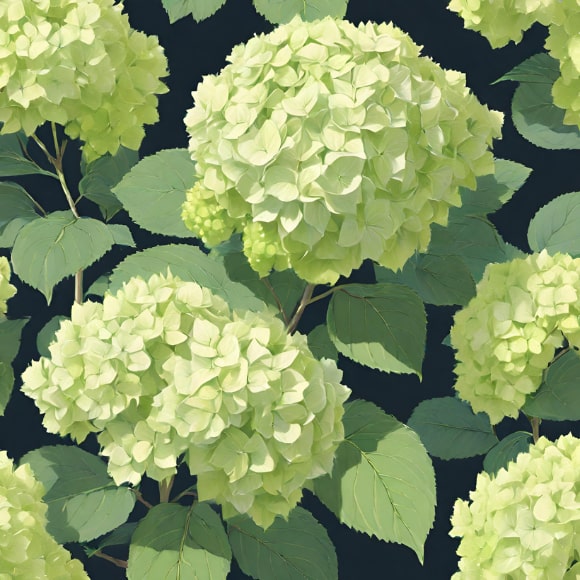Overview
Limelight Hydrangea, a cultivar of the panicle hydrangea, is celebrated for its unique and eye-catching lime-green to white flower clusters. With its distinctive coloration and robust blooms, this hydrangea variety has become a popular choice among gardeners seeking a striking focal point for their landscapes.
Description
Foliage
Limelight Hydrangea features large, dark green leaves that provide a lush backdrop to its show-stopping flower clusters. The foliage is oval-shaped and serrated, contributing to the overall visual appeal of the plant.
Flowers
The most distinctive feature of the Limelight Hydrangea is its conical flower clusters that open in a unique lime-green color, later transitioning to creamy white. These blooms are known for their longevity, maintaining their attractive color throughout the blooming season.
Size
This hydrangea variety typically reaches a height and width of 6 to 8 feet, forming a well-shaped and upright shrub that adds vertical interest to garden designs.
Growing Conditions
Soil pH
Limelight Hydrangea is adaptable to a range of soil pH levels, but it thrives in slightly acidic to slightly alkaline soil conditions. A pH range of 6.0 to 7.5 is suitable for optimal growth. The plant’s ability to tolerate various pH levels makes it versatile and easier to incorporate into different garden settings.
Sun Requirements
These hydrangeas perform best in full sun to partial shade conditions. While they can tolerate partial shade, providing ample sunlight encourages robust flowering and vibrant coloration. Planting in a location with morning sun and afternoon shade is often recommended, especially in regions with intense sunlight.
Watering
Limelight Hydrangeas appreciate consistently moist soil, and regular watering is crucial, especially during dry periods. Adequate irrigation helps maintain the plant’s health and supports the development of large and vibrant blooms. Mulching around the base of the plant helps retain soil moisture and regulates soil temperature.
Hardiness Zones
Limelight Hydrangea is well-suited for planting in USDA hardiness zones 3 to 8. This broad range of zones makes it adaptable to various climates, from cold northern regions to milder southern landscapes. The plant’s ability to withstand a range of temperatures enhances its versatility and makes it a reliable choice for gardeners across different geographic areas.
Best Planting Time
The optimal time for planting Limelight Hydrangeas is in the Spring or Fall when temperatures are moderate. Planting during these seasons allows the shrub to establish a strong root system before facing more extreme weather conditions.
Maintenance Tips
To ensure the continued health and abundant blooms of your Limelight Hydrangea, consider the following maintenance tips.
Pruning
Limelight Hydrangeas bloom on new wood, making them responsive to pruning. Pruning is typically done in late Winter or early Spring before new growth begins. Removing older stems encourages the development of new shoots and promotes prolific flowering.
Fertilization
Apply a balanced, slow-release fertilizer in Spring to support overall growth and flowering. Avoid excessive fertilization, as panicle hydrangeas are not heavy feeders.
Mulching
Mulch around the base of the plant with organic materials like shredded bark or compost. Mulching helps retain soil moisture, suppress weeds, and maintain a consistent soil temperature.
Winter Protection
In colder climates, providing a layer of mulch around the base of the plant helps insulate the roots and protect them from Winter frost. While Limelight Hydrangeas are generally hardy, this extra layer of protection can be beneficial during extreme cold spells.
Regular Monitoring
Keep an eye on soil moisture levels, especially during hot and dry periods. Regular monitoring allows you to adjust watering practices, ensuring that the plant receives adequate hydration.
Landscaping Uses
Limelight Hydrangeas offer versatility in landscaping designs. Here are some popular uses in garden settings.
Specimen Plant
Planted as a stand-alone shrub, Limelight Hydrangea serves as a striking specimen plant, drawing attention with its vibrant and unique flower clusters.
Mixed Borders
Combining Limelight Hydrangeas with other shrubs, perennials, and ornamental grasses adds visual interest and dynamic contrast to mixed borders.
Hedging
Planting multiple Limelight Hydrangeas in a row creates an attractive and informal hedge, providing privacy and a burst of color.
Container Gardening
Suitable for large containers, these hydrangeas can be grown on patios or decks, allowing for mobility and flexibility in garden design.
Cut Flower Gardens
The long-lasting blooms of Limelight Hydrangeas make them an excellent choice for cut-flower gardens, providing fresh or dried flowers for floral arrangements.
Limelight Hydrangea, with its unique coloration and adaptability, stands as a captivating addition to gardens across a range of climates. Its vibrant flowers and lush foliage make it a popular choice among gardeners seeking a plant that combines visual impact with ease of care. By understanding its specific soil, sun, and watering requirements, gardeners can enjoy the striking beauty of Limelight Hydrangea and create a dynamic landscape centerpiece.


 Previous
Previous


